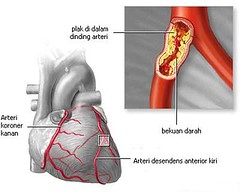In this article I will discuss what it is about coronary heart disease and its prevention.
Definition
Coronary Artery Disease / coronary heart disease characterized by fatty deposits that gather in the cells lining the wall of a coronary artery and block blood flow.
Fatty deposits (atheroma or plaque) formed gradually and spread over a large divergence of the two main coronary arteries, which surrounds the heart and supply blood to the heart.
Atheroma formation process is called atherosclerosis.
Coronary Artery Disease / coronary heart disease characterized by fatty deposits that gather in the cells lining the wall of a coronary artery and block blood flow.
Fatty deposits (atheroma or plaque) formed gradually and spread over a large divergence of the two main coronary arteries, which surrounds the heart and supply blood to the heart.
Atheroma formation process is called atherosclerosis.
Atheroma can protrude into the artery and causes the arteries to become narrow.
If the atheroma continues to enlarge, part of the atheroma may rupture and enter the bloodstream or blood clot may form on the surface of the atheroma.
To be able to contract and pump normally, the heart muscle (myocardium) requires a supply of oxygen-rich blood from the coronary arteries.
If a coronary artery blockage gets worse, it could happen ischemia (reduced blood supply) to the heart muscle, causing heart damage.
The main cause of myocardial ischemia is coronary artery disease.
The main complications of coronary artery disease is angina and heart attack (myocardial infarction).
If the atheroma continues to enlarge, part of the atheroma may rupture and enter the bloodstream or blood clot may form on the surface of the atheroma.
To be able to contract and pump normally, the heart muscle (myocardium) requires a supply of oxygen-rich blood from the coronary arteries.
If a coronary artery blockage gets worse, it could happen ischemia (reduced blood supply) to the heart muscle, causing heart damage.
The main cause of myocardial ischemia is coronary artery disease.
The main complications of coronary artery disease is angina and heart attack (myocardial infarction).
Cause
Coronary artery disease can affect all races, but the highest incidence rate found in white people. But the race itself seems not an important factor in one's lifestyle.
Specifically, factors that increase the risk of coronary artery disease are:
- Diets rich in fat
- Smoke
- Lazy to exercise
Cholesterol and Coronary Artery Disease
The risk of coronary artery disease increased in elevated levels of total cholesterol and LDL cholesterol (bad cholesterol) in the blood.
If an increase in HDL cholesterol (good cholesterol), then the risk of coronary artery disease will decrease.
Food affects the levels of total cholesterol and therefore food also affects the risk of coronary artery disease. Changing your diet (and if necessary take the drug from a doctor) can lower cholesterol levels. Lower total cholesterol and LDL cholesterol can slow or halt the progression of coronary artery disease.
Reduce levels of LDL are very big advantage for someone who has the following risk factors:
- Cigarette smoking
- High blood pressure
- Obesity
- Lazy exercise
- High triglyceride levels
- Descent
- Steroids male (androgens).
Symptoms
- Chest pain (angina). You may feel pressure or tightness in the chest, as if someone were standing on your chest. The pain, called angina, usually triggered by physical or emotional stress. It usually goes away within a few minutes after stopping the activity that causes pressure.
- Chest pain (angina). You may feel pressure or tightness in the chest, as if someone were standing on your chest. The pain, called angina, usually triggered by physical or emotional stress. It usually goes away within a few minutes after stopping the activity that causes pressure.
- Shortness of breath. If the heart can not pump enough blood to meet the needs of your body, you may experience shortness of breath or extreme fatigue without exertion.
- Heart attack. If a coronary artery becomes completely blocked, you may be experiencing a heart attack. Classic symptoms of a heart attack include chest suffocating pressure and pain in the shoulder or arm, sometimes with shortness of breath and sweating.
Prevention
The risk of coronary artery disease can be reduced by taking the following measures:
- Quit smoking
- Lowering blood pressure
- Losing weight
- Doing sports

No comments:
Post a Comment